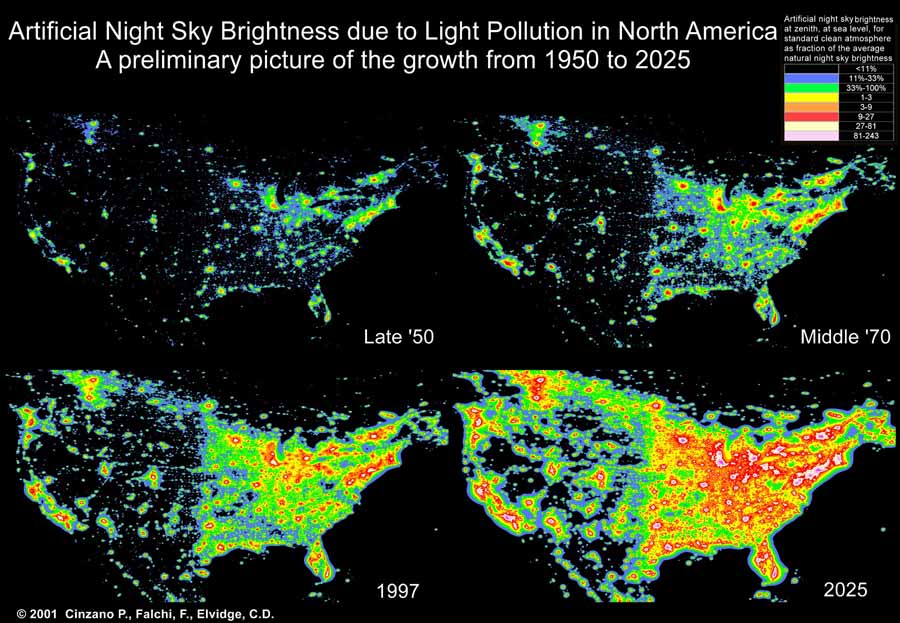
The maps show artificial night sky brightness and are based on upward light measured by the Defense Meteorological Satellite Program after accounting for propagation and scattering of that light in the atmosphere.
The night sky in all areas here which are not black (but have other colors) is considered polluted. Today, two thirds of the USA's population have lost naked eye visibility of the Milky Way.
Frame 1: late 1950's Simulation of artificial night sky brightness in late 1950's based on rescaling of 1997 data
Frame 2: mid 1970's Simulation of artificial night sky brightness in mid 1970's based on rescaling of 1997 data
Frame 3: 1997 Based on measurements in this period provided by the Defense Meteorological Satellite Program
Frame 4: 2025 Prediction of artificial night sky brightness in 2025, assuming a constant growth rate of 6% per year
Scaling derivations are explained in: Cinzano P., 2002, The growth of the artificial night sky brightness in North America in the period 1947-2000: a preliminary picture, in Light Pollution: a Global View, ed. H. Schwarz, Kluwer, Dordrecht, p. 39-48
The colors indicate the artificial night sky brightness as a fraction of the average natural night sky brightness.
Black Close
to the natural sky brightness
Blue Artificial sky brightness
is more than 10% above the natural level.
Green Artificial sky brightness
is more than 33% above the natural level.
Yellow Artificial sky brightness
is equal to the natural level. (Total sky brightness is double.)
Orange The Milky Way is no
longer visible. (Artificial sky brightness is 3 - 9 times the natural level.)
Red Less than a hundred stars
are visible. (Artificial sky brightness is 9 - 27 times the natural level.)
White The North Star is no longer visible. Only the moon,
the brightest planets, and about 25 of the brightest stars are visible. (Artificial
sky brightness is 27 - 81 times the natural level.)
Pink The Big Dipper is no longer
visible. Only the moon, the brightest planets, and a handful of the brightest
stars are visible. (Artificial sky brightness is greater than 81 times the
natural level.)
The maps depict the artificial night sky brightness when looking straight up. This is calculated for sea level and a clear atmosphere.
Images provided
courtesy of the International
Dark-Sky Association.
Copyright © 2001 Cinzano, P., Falchi, F., and Elvidge, C.D.
Special thanks to Forrest Hamilton and to Sky and Telescope for their aid in extracting these images and animations from the products provided by Cinzano, Falchi, and Elvidge.